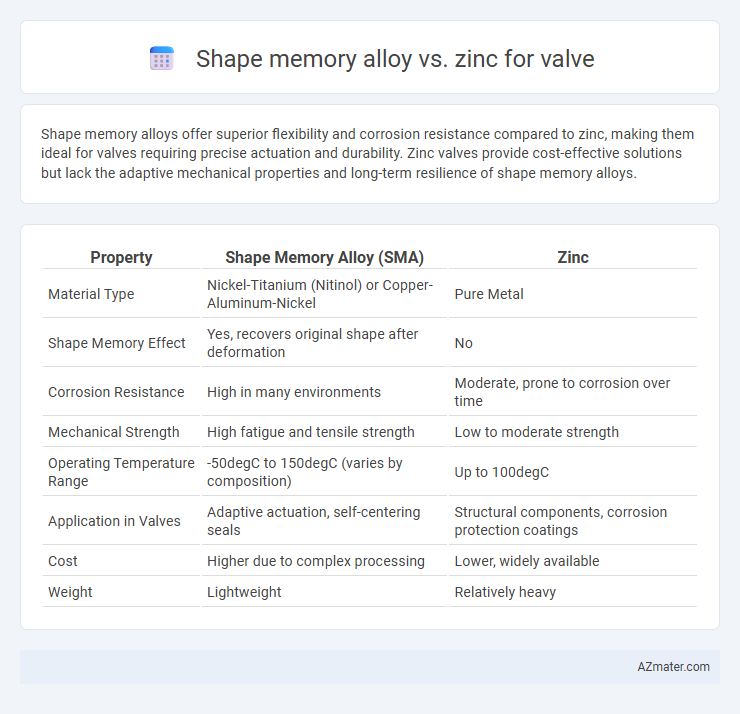Shape memory alloys offer superior flexibility and corrosion resistance compared to zinc, making them ideal for valves requiring precise actuation and durability. Zinc valves provide cost-effective solutions but lack the adaptive mechanical properties and long-term resilience of shape memory alloys.
Table of Comparison
| Property | Shape Memory Alloy (SMA) | Zinc |
|---|---|---|
| Material Type | Nickel-Titanium (Nitinol) or Copper-Aluminum-Nickel | Pure Metal |
| Shape Memory Effect | Yes, recovers original shape after deformation | No |
| Corrosion Resistance | High in many environments | Moderate, prone to corrosion over time |
| Mechanical Strength | High fatigue and tensile strength | Low to moderate strength |
| Operating Temperature Range | -50degC to 150degC (varies by composition) | Up to 100degC |
| Application in Valves | Adaptive actuation, self-centering seals | Structural components, corrosion protection coatings |
| Cost | Higher due to complex processing | Lower, widely available |
| Weight | Lightweight | Relatively heavy |
Introduction to Valve Materials
Shape memory alloys (SMAs) offer unique properties for valve applications, including high elasticity, thermal responsiveness, and corrosion resistance, making them ideal for dynamic valve components requiring precise actuation. Zinc, commonly used in valve manufacturing due to its good casting properties and moderate corrosion resistance, provides cost-effective solutions but lacks the adaptive and self-healing characteristics of SMAs. Evaluating valve materials involves balancing mechanical strength, corrosion resistance, and operational responsiveness, where SMAs outperform zinc in applications demanding enhanced durability and smart functionality.
Overview of Shape Memory Alloys
Shape memory alloys (SMAs) are advanced materials capable of returning to a predetermined shape when subjected to temperature changes, making them ideal for valve applications requiring precise actuation and self-repairing capabilities. Unlike zinc, which is primarily used for its corrosion resistance and ease of casting, SMAs offer superior mechanical properties such as high strength-to-weight ratio and excellent fatigue resistance. These characteristics allow SMA-based valves to achieve enhanced durability, responsiveness, and reduced maintenance in dynamic environments.
Properties of Zinc in Valve Applications
Zinc exhibits excellent corrosion resistance and castability, making it a cost-effective choice for valve applications where moderate strength and durability are required. Its low melting point and good fluidity enable precise molding of complex valve components, enhancing manufacturing efficiency. However, zinc's lower mechanical strength and fatigue resistance compared to shape memory alloys limit its use in high-pressure or high-stress valve environments.
Mechanical Strength Comparison
Shape memory alloys (SMAs) exhibit superior mechanical strength and high fatigue resistance compared to zinc, making them more suitable for valve applications subjected to repetitive stress and deformation. Zinc, while cost-effective and corrosion-resistant, has lower tensile strength and can deform permanently under high mechanical loads. The enhanced elasticity and shape recovery properties of SMAs provide a significant advantage in maintaining valve integrity and functionality under varying operating conditions.
Corrosion Resistance: Shape Memory Alloy vs Zinc
Shape memory alloys (SMAs) exhibit superior corrosion resistance compared to zinc, making them ideal for valve applications exposed to harsh environments. SMAs, such as nickel-titanium, naturally form a stable oxide layer that prevents degradation, whereas zinc tends to corrode more rapidly due to its sacrificial anodic properties. This enhanced corrosion resistance of SMAs results in longer valve lifespan and reduced maintenance costs.
Temperature Performance and Stability
Shape memory alloys exhibit superior temperature performance with the ability to recover deformation up to 200-300degC, maintaining stability under thermal cycling compared to zinc, which softens and loses structural integrity above 100degC. SMAs offer enhanced fatigue resistance and dimensional stability, making them ideal for valve applications requiring precise actuation at elevated temperatures. Zinc valves typically suffer from thermal expansion and corrosion issues, limiting their operational lifespan and reliability in high-temperature environments.
Longevity and Fatigue Resistance
Shape memory alloys (SMAs) exhibit superior longevity and fatigue resistance compared to zinc in valve applications due to their ability to undergo reversible phase transformations without permanent deformation. Zinc, while corrosion-resistant, tends to experience fatigue failure under cyclic loading, limiting its lifespan in dynamic valve environments. The enhanced fatigue resistance and durability of SMAs make them ideal for valves requiring repeated actuation and extended service life.
Manufacturing and Cost Considerations
Shape memory alloys (SMAs) offer superior flexibility and corrosion resistance in valve manufacturing, enabling complex geometries and durability in high-stress environments. Zinc valves, while easier and cheaper to manufacture due to lower melting points and simpler casting processes, often face limitations in mechanical strength and wear resistance. The higher production cost of SMAs is justified by enhanced performance and longevity, whereas zinc valves provide a cost-effective option for low-pressure applications with moderate durability requirements.
Application Suitability in Industry
Shape memory alloys (SMAs) offer superior fatigue resistance and self-healing properties, making them ideal for dynamic valve applications in aerospace and biomedical industries. Zinc, with its excellent corrosion resistance and cost-effectiveness, suits valve applications in plumbing and low-pressure industrial systems. SMAs excel in environments requiring precision actuation and temperature responsiveness, while zinc is preferred for durability in chemically mild conditions.
Environmental Impact and Sustainability
Shape memory alloys (SMAs) demonstrate superior environmental sustainability for valve applications due to their durability and recyclability, reducing waste and resource consumption over time. Zinc, while abundant and cost-effective, poses challenges such as potential soil and water contamination through corrosion and limited lifespan leading to more frequent replacements. The use of SMAs contributes to lower carbon footprints and less environmental degradation compared to traditional zinc valves, supporting long-term ecological balance.

Infographic: Shape memory alloy vs Zinc for Valve
 azmater.com
azmater.com